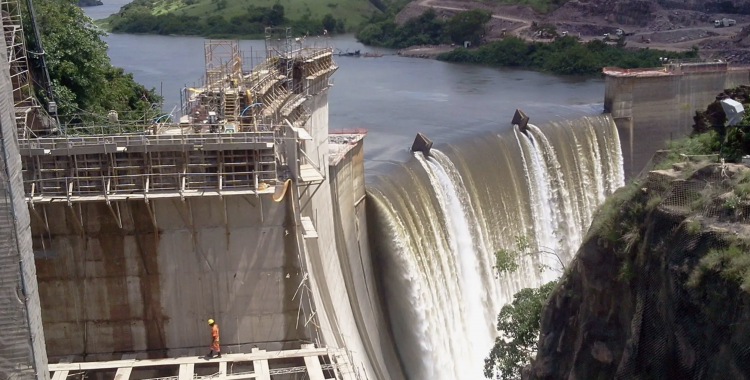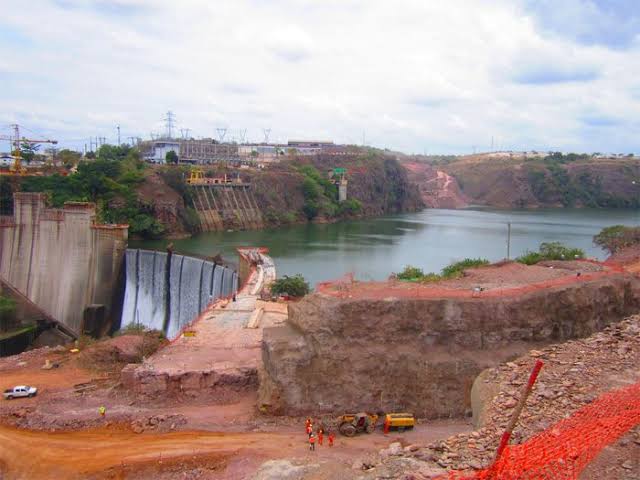The construction of the Caculo Cabaça hydropower plant in Kwanza Norte Province, Angola, has officially begun. This comes following the completion of the diversion of the Kwanza River in the locality of São Pedro da Quilemba.
The diversion of this river, on which the dam is being built, was completed on 20 May 2023. The completion of this phase was attended by the President of the Republic of Angola, João Manuel Gonçalves Lourenço.
Lourenço praised the Chinese company’s contribution to Angola’s hydropower development. He also reiterated the completion of the construction works of the hydroelectric dam of Caculo-Cabaça 2026.
Caculo Cabaça hydropower plant project overview
Developed by Angola’s Ministry of Energy and Water (MINEA), the Caculo Cabaça hydropower plant project is a 2,172MW run-of-the-river hydroelectric facility under construction in Kwanza Norte Province of the Southern Africa country, approximately 19 kilometres upstream of the Laúca hydropower station and 270 kilometres east of Angola’s capital city Luanda.
The project comprises the construction of a 103m-high concrete dam with a crest length of 553 meters. The maximum length of the reservoir will be 16.3 kilometres and an area of 16.6 km2 will be inundated. The dam’s storage capacity of 440 million cubic meters.
The dam’s hydraulic structure includes a controlled frontal spillway with five radial gates and a flow rate of 10.02m3/s. The bottom outlet of the structure is formed by two-lined tunnels while its central body comprises two saddle dams, closed by concrete weirs, 525m and 192m long, and 36m and 4m wide respectively.
The water intake structure for the Caculo Cabaça hydropower plant will be located about 2.4 kilometres upstream of the dam’s left abutment.
The project also involves the construction of an underground powerhouse equipped with four 530MW turbine-generator units, as well as a 52MW ecological power plant situated adjacent to the dam. The underground powerhouse, whose cavern measures 221m long, 26.5m-wide, and 68m-high, will receive the water supply through four 300m-long concrete-lined headrace tunnels with an inner diameter of 9m each.

The turbines inside the powerhouse will operate with a designed water flow rate of 1100m3/s, while the water operating head between the reservoir and the power plant is 215m. The water from the powerhouse will be released back to the river through two 16m-diameter, and approximately 5.1km-long concrete-lined tailrace tunnels.
Noteworthy, the 52MW ecological power plant will also have its water intake, headrace tunnel, and tailwater canal facilities. Its turbine will be designed to operate at a water flow rate of 60m3/s.
Expectations for the Caculo Cabaça hydropower plant
Upon completion, the US$ 4.53bn Caculo Cabaça hydropower plant that is being financed through an approximately US$ 4.1bn loan provided by the Industrial and Commercial Banks of China (ICBC), along with the Bank of China’s Beijing Branch, China Construction Bank of Beijing, China Minsheng Bank, Ping An Bank, and the Bank of China’s Shanghai Pilot Trade Zone Branch, is expected to generate up to 8123GWh of electricity annually.
The electricity will be evacuated through a 400kV power transmission line that is being constructed together with a 220kV ancillary substation for the ecological hydropower plant as part of the project.
Reportedly, the Caculo Cabaça hydropower plant upon completion will be the biggest hydroelectric facility in Angola, surpassing the 2,070MW installed capacity of the Laúca hydroelectric power station.
Project Timeline
2014
In 2014, COBA Group was contracted for the preparation of the final design and technical specifications for the Caculo Cabaça hydropower plant project.
2015
In June 2015, China Ghezouba Group Company (CGGC), in consortium with Boreal Investments and Niara Company signed an agreement with MINEA for the construction of the Caculo Cabaça hydropower project. The scope of the contract included the civil construction works, as well as the installation and commissioning of the hydro-mechanical and electromechanical equipment.
The final feasibility study report for the project was prepared in July 2015 by Changjiang Survey, Planning, Design, and Research Company, followed by the completion of the environmental impact study (EIS) in December of the same year. Fluidex and Progest were engaged in the preparation of the environmental impact study.
2016
In April 2016, China International Engineering Consulting Corporation (CIECC) was engaged for the consultation and technical advisory services for the Caculo Cabaça hydropower plant project.
In December same year, Ashurst advised ICBC and the syndicate of other lenders for the financing of the Caculo Cabaça hydroelectric project.
2017
The actual construction works begun in August 2017 with commissioning expected by 2024.
2018
In January, Norton Rose Fulbright provided financial advisory services for the project to the Ministry of Finance of the Republic of Angola.
2019
TPF Consultant Group was engaged for technical assistance advisory services to CGGC for the project.
2020
In November, the overall construction of the main components of the Caculo Cabaça hydropower plant project was reportedly 6.2 per cent complete. In the civil construction segment, the works on the river diversion tunnels were 91.9 per cent complete, the river diversion yard was 84% complete, the main works yard was 11.7% complete, the definitive accesses were 8.8% complete, the definitive bridge 9.1% complete, restitution exit channel 22% complete and access tunnel to the main exchange 100% complete.
The director of the Caculo Cabaça Hydroelectric Project, Augusto Chico, mentioned on November 17, 2020, that the excavation of the access tunnels to the return tunnels had begun, as well as the preparatory work for the effective start-up from the excavation and support of the fronts of the attack tunnel to the vault of the plant and the balance chimney.
Regarding the execution of the construction works of the dam, Mr Chico said they are conditional on the completion of the provisional diversion works, whose execution pace was at an advanced stage, with a record of around 91.9 per cent.


